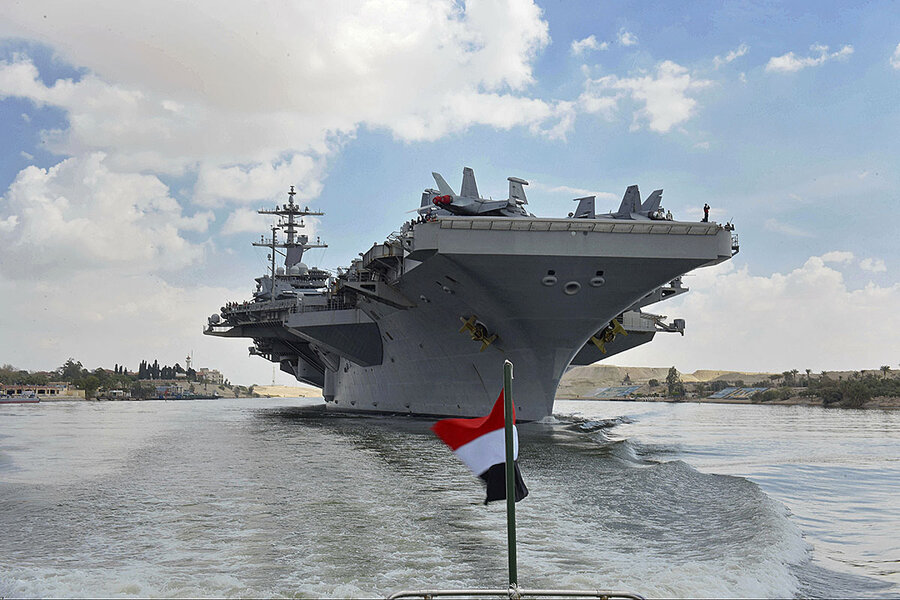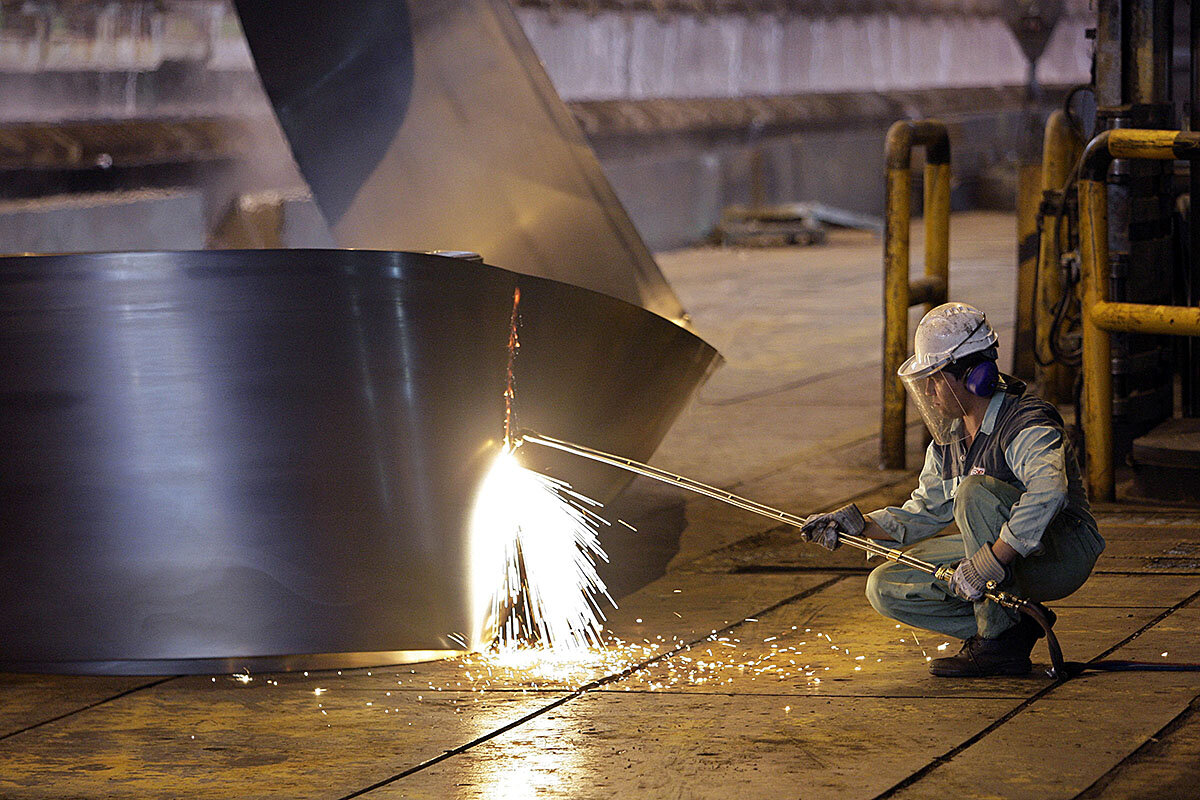Sanctions, threats, deadlines: How the Iran nuclear deal is faring
Loading...
| London
President Donald Trump is waging a “maximum pressure” campaign against Iran that includes sanctions targeting its oil exports and, most recently, a naval deployment portrayed as a “clear and unmistakable warning” in response to perceived threats. According to the International Monetary Fund, Iran’s economy is contracting, by a forecast 6% this year after 4% in 2018.
Where does that leave the landmark 2015 nuclear agreement, which saw Iran dramatically restrict its program in exchange for the lifting of sanctions but from which President Trump withdrew a year ago? On May 8 President Hassan Rouhani said Iran would suspend the sale of surplus enriched uranium and heavy water and gave European powers, Russia, and China 60 days to buck U.S. pressure and ensure that Iran receives the financial normalization the deal provides.
If they fail, he said, Iran will consider higher levels of enrichment and expand again its nuclear infrastructure, likely making the deal fall apart. The European Union said it would “reject any ultimatum” and voiced “regret” over the U.S. sanctions. Iran has set a path for incremental escalation but has chosen steps that, analysts say, can be easily reversed.
Why We Wrote This
The Iran nuclear deal was a singular accomplishment for Presidents Obama and Rouhani. But for President Trump it’s always been a “bad deal.” Now he’s testing the impact of new sanctions and putting pressure on Europe too.
Headlines shout daily about escalating tensions between the United States and Iran. The Trump White House, hardening a “maximum pressure” campaign of increased sanctions and hostile rhetoric, is now portraying the deployment of an aircraft carrier strike group as a “clear and unmistakable warning” to Iran.
The optics would seem to suggest that, exactly one year after the U.S. withdrew unilaterally from the Iran nuclear deal, a new war in the Middle East hangs in the balance. Iranian Foreign Minister Mohammad Javad Zarif says he does not expect a war but that the Trump administration is “putting things in place for accidents to happen.” In the standoff, psychological operations are paramount.
Where does that leave the landmark 2015 nuclear agreement, struck between Iran and six world powers, which saw Iran dramatically restrict its nuclear program in exchange for the lifting of sanctions?
Why We Wrote This
The Iran nuclear deal was a singular accomplishment for Presidents Obama and Rouhani. But for President Trump it’s always been a “bad deal.” Now he’s testing the impact of new sanctions and putting pressure on Europe too.
Is the nuclear deal fraying?
Despite the U.S. withdrawal, Iran has until now upheld its side of the nuclear bargain – mothballing thousands of centrifuges, exporting most of its stockpile of enriched uranium, and retooling its most sensitive nuclear sites.
Its compliance has been confirmed by more than a dozen reports by the United Nation’s nuclear watchdog agency.
But on May 8 President Hassan Rouhani, while declaring that Iran did not want to leave the agreement, said Iran would suspend the sale of surplus enriched uranium and heavy water – items capped under the deal because large quantities can be used for nuclear weapons. Just days earlier, the U.S. revoked waivers for countries to purchase excess production, thereby making compliance by Tehran extremely difficult.
And Mr. Rouhani gave European powers, Russia, and China – all parties to the deal that still support it – 60 days to buck U.S. pressure and ensure that Iran receives the financial normalization the deal provides. If they fail, he said, Iran will consider higher levels of enrichment and expand again its nuclear infrastructure – steps that would make the deal fall apart.
Iran has set a path for incremental escalation. But analysts say Iran has chosen steps that, so far, remain within the deal and can be easily reversed.
“Iran has opted for minimum retaliatory measures in response to U.S. maximum pressure,” notes the International Crisis Group. “The agreement’s erosion could well pick up pace in the next few months as Washington doubles down on its sanctions and Iran digs in.”
Are U.S. sanctions and pressure on Iran working?
Claiming that the “horrible” nuclear deal “is broken beyond repair,” President Donald Trump on May 8 marked the anniversary of his withdrawal by adding sanctions on Iranian metal exports.
In the past month, he said, the U.S. has “increased the pressure on Iran tenfold” by taking steps to force Iran’s oil exports to zero and threatening allies and adversaries alike to end business with Iran. It has designated the Islamic Revolutionary Guard Corps a terrorist organization and aims to turn frequent economic protests into a broader, regime-changing uprising.
According to the International Monetary Fund, Iran’s recession-hit economy is shrinking. It estimates GDP will contract by 6% this year, after diminishing by 4% in 2018.
The U.S. says it will further increase sanctions until Iran “fundamentally alters its conduct.” Yet while they clearly have a crippling effect – inflation quadrupled in the past year, the currency has hit record lows, and foreign investment has all but disappeared – Iran’s policies remain.
“Iran’s behavior hasn’t changed in any way,” Dina Esfandiary, a fellow at the Harvard Kennedy School’s Belfer Center for Science and International Affairs, said in a media call. She noted Iran’s continued regional role, work on missiles, and now its restarting of “some small aspects” of its nuclear program. “If anything,” she says, the U.S. pressure campaign “is further entrenching Iranian behavior.”
What does Iran’s ultimatum to Europe mean?
The Europeans are caught between the White House desire to strangle Iran’s economy and Iran’s demand that it reap benefits promised by the nuclear deal.
On May 9 the European Union called on Iran to “refrain from any escalatory steps” and said it would “reject any ultimatum.” The EU also noted “regret” that the U.S. reimposed sanctions.
But Iran is wary of Europe, noting the monthslong delay in opening a new payment mechanism launched in January, designed to enable “legitimate” trade in pharmaceuticals and food, for example, which would bypass U.S. sanctions on Iran.
What does the U.S. naval deployment indicate?
The National Security Council announced the carrier group deployment on May 5 as a response to what it called “troubling and escalatory” actions by Iran. U.S. officials suggested they had fresh intelligence that pro-Iran proxies are newly imperiling American troops in the region and that Iran was moving short-range missile onto boats in the Persian Gulf.
In fact, the U.S. Navy carrier group had been set to sail to the Middle East a month earlier, on a routine deployment. And Israeli media reported that the intelligence cited by Washington had come from an Israeli delegation two weeks earlier, during which the Mossad “drew several scenarios for what the Iranians might be planning.”
Iran dismissed the threat as “psychological warfare.” Still, Secretary of State Mike Pompeo made a surprise visit to Baghdad to brief Iraqi officials on threats to U.S. personnel from Iran-backed Shiite militias there and to warn of a robust response.









